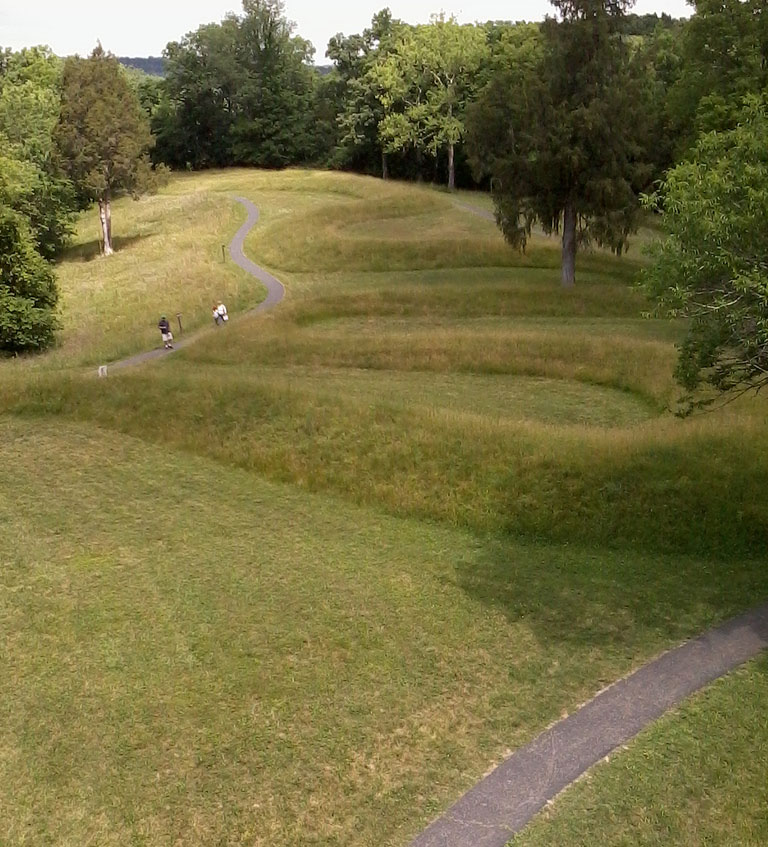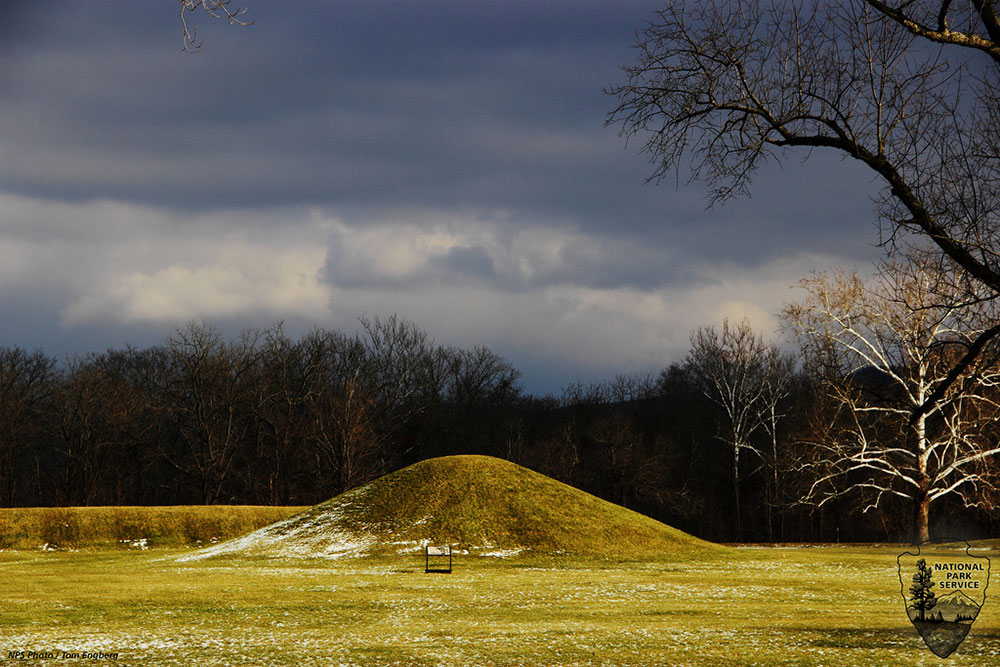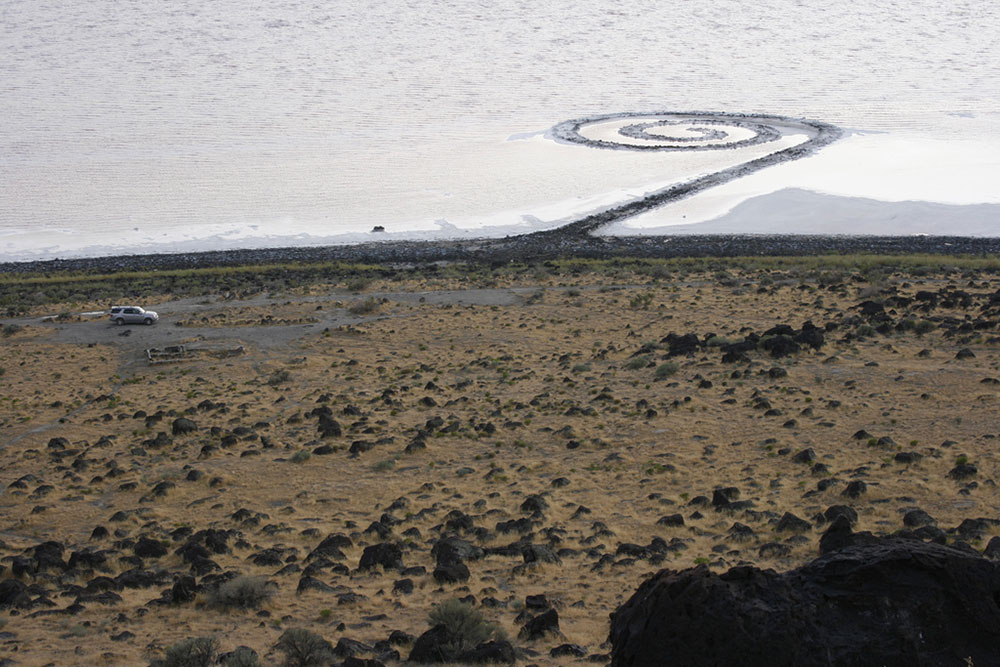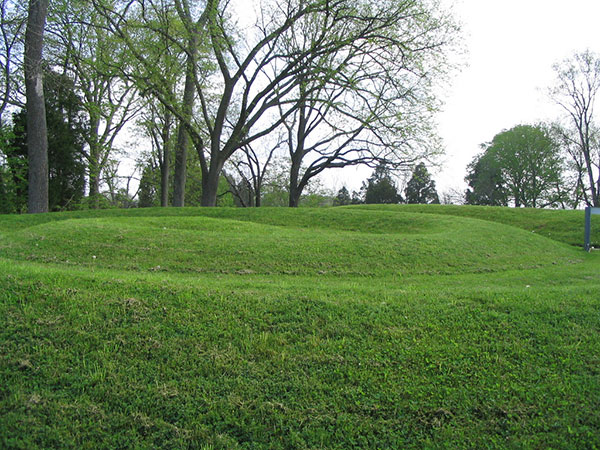On the day we went to see the Great Serpent Mound, the rain plunged from the sky. Lightning shot down to the cornfields and made the cornfields roar. Everything was dark. Guides recommend that you come to the Serpent early or late in the day, when shadows alongside it are deep and the winding shape becomes bolder. But on the day we visited, the whole of Ohio was shadow, save the neat green grass of the Serpent’s skin, which was oddly bright.
When the first European settlers came to farm southwestern Ohio, they found earthen lumps scattered all around the land. They did not know what these lumps could be — some farmers went about flattening them, others farmed around them. In the 1840s, a local doctor and a newspaper editor from the town of Chillicothe investigated the mounds. They discovered wooden structures inside, built to house the dead of Native tribes whose names are lost to us now. Jewelry and effigies were placed around the cremated remains to keep the spirits company. Then the Mound Builders covered over the structures with layers of soil and sand. As the generations passed, new dead were buried on top of the old, and more earth was put on top, until the mounds grew higher and higher and the little wooden structure collapsed within.
At first glance, the Native American earthworks of southwestern Ohio seem in disarray. But from an aerial view and with infrared technology, you can see the geometry and the patterns. The Hopewell Mound Group along the North Fork of Paint Creek is a giant parallelogram, 1,800 feet long on the east and the west sides and 2,800 feet long on the north and south. The Newark complex in Newark and Heath, Ohio includes a 1,200-foot-diameter Great Circle with a tremendous framed gateway. Each complex is a system of circles and squares in which the burial mounds were placed.

The Serpent Mound is not like the other earthworks. It does not seem directly connected to the other sites; its shape is organic and winding. When they opened up the Serpent, long ago, there was nothing but dirt inside. Burial mounds were found nearby but how they relate to the Serpent is uncertain. Like the other earthworks, no one really knows how old it is or who built it or exactly why. Standing at the top of the observation tower, you can see why the spiral at one end has been called a tail, and how the oval at the front was meant to be a head (or a head eating an egg, or a head eating a turtle, or a great eye, or the sun). Alongside the cracked asphalt path that leads visitors around the Serpent are signs. The signs tell you that the head of the serpent aligns with the summer solstice sunset, and that the tail points to the winter solstice sunrise. There appears to be this sort of astronomical significance in all the earthwork sites. Some scientists say the Octagon Earthworks – a perfect circle and adjoining octagon over a half-mile across – was a lunar observatory, conceived to follow the journey of the moon. The earthworks are of the earth – human ash and clay and ceremony and art – but they point, also, to the stars.
For 1,000 years (and some say two), the Serpent has rested in a crater caused by a meteorite or asteroid that crashed down on southwestern Ohio 300 million years ago. Watching the local historical societies’ interpretive videos, reading the information plaques next to the burial mounds, a story of the Mound Builders and their earthworks comes together, a “Golden Age” of a disappeared people and their incredible constructions. Little by little, the burial mounds – which really could be anything if you didn’t know the truth, grassy hills or old walls – start to come alive.

At Mound City in Chillicothe, hidden between the Scioto River and a vast prison complex, you can look at the mounds and imagine the layers of sand and bone inside them, see the ceremonial pots and carvings of hands and small bird effigies in the shapes of pipes that once were buried with the dead but have since been dug up for display. The materials of these objects, you learn, come from all over the country: shark’s teeth from the Atlantic Ocean, obsidian from the Rocky Mountains, mica from the Blue Ridge Mountains, shells from the Gulf of Mexico. Inside the burial mounds of Ohio are the sacred fragments of different tribes from around America, who traveled miles and miles, it’s said, to share ceremonies and collectively bury their dead. The greatest concentration of ceremonial sites is in the area around Chillicothe. But there are mounds in Georgia and mounds in Kentucky and West Virginia and Tennessee and around the Great Lakes and the Mississippi River Valley and all the way to Alabama. In seven hundred years, between 200 B.C. and A.D. 500, the woodlands of eastern and middle North America became the dwelling place of mounds. Then, just like that, the Mound Builders disappeared. By the time the Ohioans got curious about just who these lost people were, any Natives who might have had any information at all had gone the way of the mounds.
Near Rozel Point in the state of Utah, a 1,500-foot-long spiral of mud, salt crystals, basalt rocks and water moves from the northeastern shore into the Great Salt Lake. Depending on your vantage, or the time of the year, Spiral Jetty looks like a shell, or a fiddlehead fern, or a road leading back to itself.

Sometime in the late 1960s, the artist Robert Smithson took a trip to southwestern Ohio. He saw the Great Serpent Mound there and decided that he would make a great spiral too. Smithson was drawn to these prehistoric structures and the mysteries of civilization’s relationship with time. Spiral Jetty is like the Serpent’s tail blown out of proportion and stuck in the wastelands of Utah, juxtaposed against a dilapidated industrial pier and some rusty oil rigs. In the beginning, the spiral was black basalt rock against the red water of the Lake. But over time, salt crusted over the rock, turning Spiral Jetty pink and white. Because the Great Salt Lake’s levels vary several feet from year to year, and also from season to season, Spiral Jetty is not always visible even if you make the trip to Utah. You could go out to Spiral Jetty and find that the entire earthwork is invisible underwater. When Robert Smithson created this earthwork in 1970, he did not care if it could be easily seen or who owned it. And so, even today, no one knows to whom Spiral Jetty really belongs. To view it requires a pilgrimage.
In his essay “Entropy And The New Monuments (1966),” Smithson tried to put his monumental art and that of other like-minded artists into context. The New Monuments, wrote Smithson, evoke the Ice Age rather than the Golden Age, “and would most likely confirm Vladimir Nabokov’s observation that, ‘The future is but the obsolete in reverse.’”
Instead of causing us to remember the past like the old monuments, the new monuments seem to cause us to forget the future. … They are not built for the ages, but rather against the ages. They are involved in a systematic reduction of time down to fractions of seconds, rather than in representing the long spaces of centuries. Both past and future are placed into an objective present. This kind of time has little or no space; it is stationary and without movement, it is going nowhere …
Architects, Smithson once said in an interview, tend to be idealists. They look at their structures and think about how they will cover over the earth. They try not to picture their buildings fallen into ruin, sucked back into the landscape they once sat upon. American builders are especially idealistic because the land they were given to build on since the beginning has been thought of as empty space. This is unlike Rome, for instance, which, as Smithson put it, is like “a big scrap heap of antiquities.” “America,” said Smithson, “doesn’t have that kind of historical background of debris,” and so Americans don’t often think of monuments the way Europeans do, as potential ruins, subject to entropy, subject to change, involved in the story of Time. Time, for Americans, goes mostly in a straight line, from Point A to Point B, with all things getting bigger and better, even when they collapse. For Smithson, time was like a spiral dissolving in salt, neither static nor cyclical but just moving, just going, disappearing and coming back again.

When Robert Smithson saw the Great Serpent Mound almost five decades ago, he saw a monument that had become one with nature. The Serpent Mound didn’t look, to Smithson, like an observatory, or a ceremonial meeting place, or a burial ground or an artwork; it looked like something that nature had created in collaboration with people. Smithson wanted Spiral Jetty to merge with nature too, not as a testimony to man’s mastery over nature – as monuments and architecture of the past – nor even as testimony to man’s oneness with nature. Spiral Jetty, like the Serpent Mound, is a revelation rather than a declaration.
Maybe that is what the earthworks of the ancient Native Americans have in common with the earthworks of contemporary art. The Mound Builders were, in their way, the original American architects. But unlike modern architecture, earthworks have what might be called an intentional disappearance. When archaeologists looked inside the mounds a hundred and seventy years ago, they saw the remnants of wooden structures. Only, the structures were covered over with earth, destined to collapse, and be swallowed by the land. •
Photos by Ghostfire Photography via Flickr (Creative Commons), DennyMont via Flickr (Creative Commons), Outlier Babe via Flickr (Creative Commons), Hopewell Culture National Historical Park via Flickr (Creative Commons), David O. Stevens via Flickr (Creative Commons),The Last Cookie via Flickr (Creative Commons),




